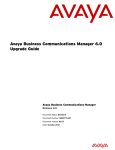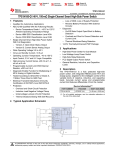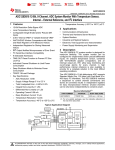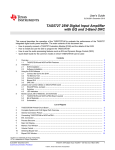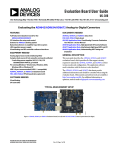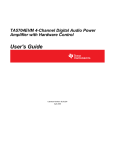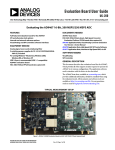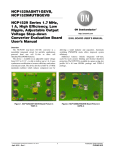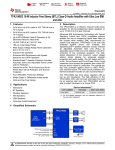Download Booxt GOES 300S Specifications
Transcript
Sample & Buy Product Folder Support & Community Tools & Software Technical Documents LM3269 SNVS793D – NOVEMBER 2011 – REVISED MAY 2015 LM3269 Seamless-Transition Buck-Boost Converter for 3G and 4G RF Power Amplifiers 1 Features 3 Description • • • • The LM3269 is buck-boost DC-DC converter designed to generate output voltages above or below a given input voltage and is particularly suitable for portable applications powered by a single-cell Li-ion battery. 1 • • • • • • Operates From a Single Li-Ion Cell: 2.7 V to 5.5 V Adjustable Output Voltage: 0.6 V to 4.2 V Automatic PFM or PWM Mode Change 750-mA Maximum Load Capability for VBATT ≥ 3 V, VOUT = 3.8 V 2.4-MHz (typical) Switching Frequency Seamless Buck-Boost Mode Transition Fast Output Voltage Transition: 1.4 V to 3 V in 10 µs High-Efficiency: 95% typical at VBATT = 3.7 V, VOUT = 3.3 V, at 300 mA Input Overcurrent Limit Internal Compensation The LM3269 operates at a 2.4-MHz typical switching frequency in full synchronous operation and provides seamless transitions between buck and boost operating regimes. The LM3269 operates in energysaving Pulse Frequency Modulation (PFM) mode for increased efficiencies and current savings during lowpower RF transmission modes. The power converter topology needs only one inductor and two capacitors. A unique internal power switch topology enables high overall efficiency. The LM3269 is internally compensated for buck and boost modes of operation, thus providing an optimal transient response. 2 Applications • • • • Power Supply for 3G/4G Power Amplifiers Cellular Phones Portable Hard Disk Drives PDAs When considering using the LM3269 in a system design, please review the layout instruactions at the end of this document. Device Information(1) PART NUMBER LM3269 PACKAGE BODY SIZE (MAX) DSBGA (12) 2.529 mm x 2.022 mm (1) For all available packages, see the orderable addendum at the end of the data sheet. Typical Application 2.2 PH SW1 SW2 VBATT: 2.7V to 5.5V VOUT: 0.6V to 4.2V PVIN VOUT PVIN FB RF PA LM3269 + - 10 PF 4.7 PF EN VCON SGND PGND GPO1 BB RFIC DAC 1 An IMPORTANT NOTICE at the end of this data sheet addresses availability, warranty, changes, use in safety-critical applications, intellectual property matters and other important disclaimers. PRODUCTION DATA. LM3269 SNVS793D – NOVEMBER 2011 – REVISED MAY 2015 www.ti.com Table of Contents 1 2 3 4 5 6 7 Features .................................................................. Applications ........................................................... Description ............................................................. Revision History..................................................... Pin Configuration and Functions ......................... Specifications......................................................... 1 1 1 2 3 4 6.1 6.2 6.3 6.4 6.5 6.6 6.7 6.8 4 4 4 4 5 5 6 7 Absolute Maximum Ratings ...................................... ESD Ratings.............................................................. Recommended Operating Conditions....................... Thermal Information .................................................. Electrical Characteristics........................................... System Characteristics ............................................ Switching Characteristics .......................................... Typical Characteristics .............................................. Detailed Description .............................................. 9 7.1 Overview ................................................................... 9 7.2 Functional Block Diagram ......................................... 9 7.3 Feature Description................................................. 10 7.4 Device Functional Modes........................................ 10 8 Application and Implementation ........................ 11 8.1 Application Information............................................ 11 8.2 Typical Application ................................................. 11 9 Power Supply Recommendations...................... 14 10 Layout................................................................... 15 10.1 Layout Guidelines ................................................. 15 10.2 Layout Examples................................................... 18 10.3 DSBGA Package Assembly And Use ................... 20 11 Device and Documentation Support ................. 21 11.1 11.2 11.3 11.4 11.5 Device Support...................................................... Documentation Support ........................................ Trademarks ........................................................... Electrostatic Discharge Caution ............................ Glossary ................................................................ 21 21 21 21 21 12 Mechanical, Packaging, and Orderable Information ........................................................... 21 4 Revision History Changes from Revision C (May 2013) to Revision D Page • Added Device Information table, Pin Configuration and Functions section, ESD Rating table, Feature Description , Device Functional Modes, Application and Implementation, Power Supply Recommendations, Device and Documentation Support , and Mechanical, Packaging, and Orderable Information sections ................................................ 1 • Deleted Recommended Capacitance Specifications table as info contained in other tables .............................................. 12 Changes from Revision B (August 2012) to Revision C • 2 Page Changed product brief to full data sheet ............................................................................................................................... 1 Submit Documentation Feedback Copyright © 2011–2015, Texas Instruments Incorporated Product Folder Links: LM3269 LM3269 www.ti.com SNVS793D – NOVEMBER 2011 – REVISED MAY 2015 5 Pin Configuration and Functions YZR Package 12-Pin DSBGA Top View A1 A2 A3 A3 A2 A1 B1 B2 B3 B3 B2 B1 C1 C2 C3 C3 C2 C1 D1 D2 D3 D3 D2 D1 Top View Bottom View Pin Functions PIN NUMBER NAME A1 NC (1) TYPE (1) DESCRIPTION — Non Connection. Leave this pin floating; do not connect to PVIN or PGND. A2 NC — Non Connection. Leave this pin floating, do not connect to PVIN or PGND. A3 PVIN P/I Power MOSFET input and power current input pin. Optional low-pass filtering may help buck and buck-boost modes for radiated EMI and noise reduction. B1 VCON A/I Voltage Control analog input. VCON controls the output voltage in PWM and PFM modes. B2 EN D/I Enable pin. Pulling this pin higher than 1.2 V enables part to function. B3 PVIN P/I Power MOSFET input and power current input pin. Optional low-pass filtering may help buck and buck-boost modes for radiated EMI and noise reduction. C1 FB A Feedback input to inverting input of error amplifier. Connect output voltage directly to this node at load point. C2 SGND G Signal Ground for analog circuits and control circuitry. C3 SW1 P/O D1 VOUT O D2 SW2 P/O D3 PGND G Switch pin for Internal Power Switches. Connect inductor between SW1 and SW2. Regulated output voltage of the LM3269. Connect this to a 4.7-µF ceramic output filter capacitor to GND. Switch pin for Internal Power Switches. Connect inductor between SW1 and SW2. Power Ground for Power MOSFETs and gate drive circuitry. A: Analog Pin, D: Digital Pin, G: Ground Pin, P: Power Pin, I: Input Pin, O: Output Pin. Submit Documentation Feedback Copyright © 2011–2015, Texas Instruments Incorporated Product Folder Links: LM3269 3 LM3269 SNVS793D – NOVEMBER 2011 – REVISED MAY 2015 www.ti.com 6 Specifications 6.1 Absolute Maximum Ratings over operating free-air temperature range (unless otherwise noted) (1) (2) PVIN, VOUT to GND MIN MAX −0.2 6 UNIT V (3) V EN, VCON to SGND, PGND −0.2 PVIN + 0.2 V or 6 V FB to PGND −0.2 VOUT + 0.2 V or 6 V (3) V SW1, SW2 −0.2 PVIN + 0.2 V or 6 V (3) V Continuous power dissipation (4) Internally limited Junction temperature, TJ-MAX −65 Storage temperature, Tstg (1) (2) (3) (4) 150 °C 150 °C Stresses beyond those listed under Absolute Maximum Ratings may cause permanent damage to the device. These are stress ratings only, which do not imply functional operation of the device at these or any other conditions beyond those indicated under Recommended Operating Conditions. Exposure to absolute-maximum-rated conditions for extended periods may affect device reliability. If Military/Aerospace specified devices are required, please contact the Texas Instruments Sales Office/Distributors for availability and specifications. Whichever is smaller. Internal thermal circuitry protects the device from permanent damage. Thermal shutdown engages at TJ = 150°C (typical) and disengages at TJ = 125°C (typical). 6.2 ESD Ratings V(ESD) (1) Electrostatic discharge Human-body model (HBM), per ANSI/ESDA/JEDEC JS-001 VALUE UNIT ±2000 V (1) JEDEC document JEP155 states that 500-V HBM allows safe manufacturing with a standard ESD control process. 6.3 Recommended Operating Conditions over operating free-air temperature range (unless otherwise noted) (1) (2) MIN NOM MAX UNIT Input voltage 2.7 5.5 Output voltage 0.6 4.2 V 0 750 mA Junction temperature (TJ) −30 125 °C Ambient temperature (TA) (3) −30 85 °C Recommended load current (1) (2) (3) V Stresses beyond those listed under absolute maximum ratings may cause permanent damage to the device. These are stress ratings only, and functional operation of the device at these or any other conditions beyond those indicated under recommended operating conditions is not implied. Exposure to absolute-maximum-rated conditions for extended periods may affect device reliability. All voltages are with respect to the potential at the GND pins. In applications where high power dissipation and/or poor package thermal resistance is present, the maximum ambient temperature may have to be de-rated. Maximum ambient temperature (TA-MAX) is dependent on the maximum operating junction temperature (TJ-MAX-OP = 125°C), the maximum power dissipation of the device in the application (PD-MAX), and the junction-to ambient thermal resistance of the part/package in the application (RθJA), as given by the following equation: TA-MAX = TJ-MAX-OP – (RθJA × PD-MAX). 6.4 Thermal Information LM3269 THERMAL METRIC (1) YZR (DSBGA) UNIT 12 PINS RθJA (1) (2) 4 Junction-to-ambient thermal resistance (2) 85 °C/W For more information about traditional and new thermal metrics, see the IC Package Thermal Metrics application report, SPRA953. Junction-to-ambient thermal resistance is highly application and board-layout dependent. In applications where high maximum power dissipation exists, special care must be paid to thermal dissipation issues in board design. Junction-to-ambient thermal resistance (RθJA) is taken from a thermal modeling result, performed under the conditions and guidelines set forth in the JEDEC standard JESD51-7. Submit Documentation Feedback Copyright © 2011–2015, Texas Instruments Incorporated Product Folder Links: LM3269 LM3269 www.ti.com SNVS793D – NOVEMBER 2011 – REVISED MAY 2015 6.5 Electrical Characteristics Unless otherwise specified, typical (TYP) limits are for TA = TJ = 25°C, and minimum (MIN) and maximum (MAX) limits apply over the full operating ambient temperature range (−30°C ≤ TJ = TA ≤ +85°C). Unless otherwise noted, specifications apply to the Figure 16 with: PVIN = EN = 3.6V. (1) (2) MIN TYP MAX VFB, min Min FB voltage PARAMETER VCON = 0.2 V 0.53 0.60 0.67 VFB, max Max FB voltage VCON = 1.4 V 4.13 4.2 4.27 Quiescent current No switching (3) 0.9 1.2 mA ISHDN Shutdown supply current EN = 0 V, VCON = 0 V, SW1 = SW2 = VOUT = 0 V 0.02 5 µA ILIM_L Input current limit (large) Open loop (4) VCON = 1.2 V 1500 1700 1900 750 850 IQ_PWM TEST CONDITIONS ILIM_S Input current limit (small) Open loop VCON = 0.2 V Gain Internal gain (5) 0.2 V ≤ VCON ≤ 1.4 V IEN EN pin pulldown current IVCON VCON pin leakage current –1 VIH Logic high input threshold for EN 1.2 VIL Logic low input threshold for EN IOUT_LEAKAGE Leakage into VOUT pin of buckboost (3) (4) (5) V mA (4) (1) (2) UNIT 3 5 V/V 10 1 0.6 EN = 0 V, VOUT ≤ 4.2 V PVIN ≤ 5.5 V 5 µA V µA All voltages are with respect to the potential at the GND pins. Min and Max limits are specified by design, test, or statistical analysis. Typical numbers are not verified, but do represent the most likely norm. IQ specified here is when the part is not switching. The parameters in the electrical characteristics table are tested under open loop conditions at PVIN = 3.6 V. To calculate VOUT, use the following equation: VOUT = VCON × 3. 6.6 System Characteristics The following spec table entries are specified by design and verification provided the component values in the typical application circuit are used (L = 2.2 µH, DCR = 110 mΩ, MIPSZ2520D2R2/FDK; CIN = 10 µF, 6.3 V, C1608X5R0J106K/TDK (0603); COUT = 4.7 µF, 6.3 V, C1608X5R0J475M/TDK (0603). These parameters are not verified by production testing. Typical (TYP) limits are for TA = TJ = 25°C; minimum (MIN) and maximum (MAX) limits apply over the full operating ambient temperature range (−30°C ≤ TJ = TA ≤ 85°C) and over the VBATT = PVIN = 2.7 V to 5.5 V, unless otherwise specified. PARAMETER TEST CONDITIONS MIN TYP MAX IOUT_MAX Max output current VBATT ≥ 3 V, VOUT = 3.8 V VCON_LIN VCON linearity 0.2 V ≤ VCON ≤ 1.4 V Ripple voltage VBATT ≥ 3.2 V, 0.6 V ≤ VOUT ≤ 4.2 V, 0 mA ≤ IOUT ≤ 430 mA, TA = 25°C 15 PFM ripple VOUT = 0.6 V, IOUT = 5 mA 45 Ripple voltage in mode transition VBATT = 3 V to 5 V, TR = TF = 30 µs 3.3 V ≤ VOUT ≤ 4.2 V 50 Line regulation VBATT = 2.7 V to 4.7 V, VOUT = 3.8 V, IOUT = 500 mA 10 Load regulation IOUT = 0 mA to 500 mA, VBATT = 2.7 V to 4.7 V 20 VOUT rise time VBATT = 3.2 V to 4.7 V, VOUT = 1.4 V to 3 V, 0.1 µs < Tr_VCON < 1 µs RLOAD = 11.4 Ω VO_RIPPLE ΔVOUT VOUT_TR 750 mA –2.5% 2.5% 50 mV 10 Submit Documentation Feedback Copyright © 2011–2015, Texas Instruments Incorporated Product Folder Links: LM3269 UNIT mV µs 5 LM3269 SNVS793D – NOVEMBER 2011 – REVISED MAY 2015 www.ti.com System Characteristics (continued) The following spec table entries are specified by design and verification provided the component values in the typical application circuit are used (L = 2.2 µH, DCR = 110 mΩ, MIPSZ2520D2R2/FDK; CIN = 10 µF, 6.3 V, C1608X5R0J106K/TDK (0603); COUT = 4.7 µF, 6.3 V, C1608X5R0J475M/TDK (0603). These parameters are not verified by production testing. Typical (TYP) limits are for TA = TJ = 25°C; minimum (MIN) and maximum (MAX) limits apply over the full operating ambient temperature range (−30°C ≤ TJ = TA ≤ 85°C) and over the VBATT = PVIN = 2.7 V to 5.5 V, unless otherwise specified. PARAMETER η Efficiency TEST CONDITIONS MIN TYP VBATT = 3.7 V, VOUT = 0.6 V, IOUT = 10 mA −30°C ≤ TJ = TA ≤ 85°C 61% VBATT = 3.7 V, VOUT = 1 V IOUT = 20 mA −30°C ≤ TJ = TA ≤ 85°C 78% VBATT = 3.7 V, VOUT = 1.4 V IOUT = 50 mA −30°C ≤ TJ = TA ≤ 85°C 85% VBATT = 3.7 V, VOUT = 2.7 V IOUT = 200 mA −30°C ≤ TJ = TA ≤ 85°C 95% VBATT = 3.7 V, VOUT = 3.3 V, IOUT = 480 mA −30°C ≤ TJ = TA ≤ 85°C 94% VBATT = 3 V, VOUT = 3.6 V, IOUT = 200 mA −30°C ≤ TJ = TA ≤ 85°C 95% MAX UNIT 6.7 Switching Characteristics over operating free-air temperature range (unless otherwise noted) PARAMETER TYP MAX TON EN = L to H, VBATT = 3.7 V, VOUT = Turnon time (time for output to reach 3.5 V, 0V→90% × 3.5 V) IOUT = 0 mA −30°C ≤ TJ = TA ≤ 85°C 35 50 FOSC_PFM PFM operating frequency VBATT = 3.7 V, VOUT = 0.6 V, IOUT = 13 mA 63 FOSC_PWM Internal oscillator frequency PWM DMAX Maximum duty cycle VOUT_TR 6 VCON change to 90% TEST CONDITIONS MIN 2.1 2.4 2.7 50% Buck 100% Submit Documentation Feedback 10 µs kHz Boost VBATT = 3.2 V to 4.7 V, VOUT = 1.4 V to 3 V, 0.1 µs < Tr_VCON < 1 µs RLOAD = 11.4 Ω UNIT MHz µs Copyright © 2011–2015, Texas Instruments Incorporated Product Folder Links: LM3269 LM3269 www.ti.com SNVS793D – NOVEMBER 2011 – REVISED MAY 2015 6.8 Typical Characteristics (PVIN = EN = 3.6 V and TA = 25°C, unless otherwise noted) VCON = VOUT = SW1 = SW2 = EN = 0 V VOUT = 3.5 V Figure 1. Shutdown Current vs. Temperature IOUT = 300 mA Figure 2. Switching Frequency vs. Temperature 100 90 EFFICIENCY (%) 80 70 60 50 40 30 PVIN = 2.7V PVIN = 3.0V PVIN = 3.6V PVIN = 4.2V PVIN = 4.8V 20 10 0 0 20 40 60 80 100 OUTPUT LOAD (mA) 120 VOUT = 0.6 V Figure 4. PFM Efficiency 100 100 90 90 80 80 EFFICIENCY (%) EFFICIENCY (%) Figure 3. VCON Voltage vs. Output Voltage (No Load) 70 60 50 40 PVIN = 2.7V PVIN = 3.0V PVIN = 3.6V PVIN = 4.2V PVIN = 4.8V 30 20 10 70 60 50 40 PVIN = 2.7V PVIN = 3.0V PVIN = 3.6V PVIN = 4.2V PVIN = 4.8V 30 20 10 0 0 0 20 40 60 80 100 OUTPUT LOAD (mA) VOUT = 1 V 120 0 20 40 60 80 100 OUTPUT LOAD (mA) 120 VOUT = 1.4 V Figure 5. PFM Efficiency Figure 6. PFM Efficiency Submit Documentation Feedback Copyright © 2011–2015, Texas Instruments Incorporated Product Folder Links: LM3269 7 LM3269 SNVS793D – NOVEMBER 2011 – REVISED MAY 2015 www.ti.com Typical Characteristics (continued) 100 100 90 90 80 70 60 PVIN = 2.7V PVIN = 3.0V PVIN = 3.6V PVIN = 4.2V 50 EFFICIENCY (%) EFFICIENCY (%) (PVIN = EN = 3.6 V and TA = 25°C, unless otherwise noted) 70 60 PVIN = 2.7V PVIN = 3.0V PVIN = 3.6V PVIN = 4.2V 50 40 40 0 100 200 300 400 500 600 700 OUTPUT LOAD (mA) VOUT = 2.4 V 0 100 200 300 400 500 600 700 OUTPUT LOAD (mA) VOUT = 3.6 V Figure 7. PWM Efficiency 8 80 Figure 8. PWM Efficiency Submit Documentation Feedback Copyright © 2011–2015, Texas Instruments Incorporated Product Folder Links: LM3269 LM3269 www.ti.com SNVS793D – NOVEMBER 2011 – REVISED MAY 2015 7 Detailed Description 7.1 Overview The LM3269 buck-boost converter provides high-efficiency, low-noise power for RF power amplifiers (PAs) in mobile phones, portable communicators, and similar battery-powered RF devices. It is designed to allow the RF PA to operate at maximum efficiency for a wide range of power levels from a single Li-Ion battery cell. The capability of the LM3269 to provide an output voltage lower than, as well as higher than, the input battery voltage enables the PA to operate with high linearity for a wide range of battery voltages, thereby extending the usable voltage range of the battery. The converter feedback loop is internally compensated for both buck and boost operation, and the architecture is such that it provides seamless transition between buck and boost modes of operation. The LM3269 operates in energy saving Pulse Frequency Modulation (PFM) mode for increased efficiencies and current savings during low-power RF transmission modes. The output voltage is dynamically programmable from 0.6 V to 4.2 V by adjusting the voltage on the control pin VCON without the need for external feedback resistors. The fast output voltage transient response of the LM3269 makes it suitable for adaptively adjusting the PA supply voltage depending on its transmitting power, which prolongs battery life. Additional features include current overload protection, output overvoltage clamp, and thermal overload shutdown. The LM3269 is constructed using a chip-scale 12-bump DSBGA package that offers the smallest possible size for space-critical applications such as cell phones, where board area is an important design consideration. Use of high switching frequency (2.4 MHz, typical) reduces the size of external components. As shown in the Typical Application Circuit, only three external power components are required for circuit operation. Use of DSBGA package requires special design considerations for implementation. (See DSBGA Package Assembly And Use) Its fine bump-pitch requires careful board design and precision assembly equipment. Use of this package is best suited for opaque-case applications where its edges are not subjected to high-intensity ambient red or infrared light. In addition, the system controller should set EN low during power-up and other low supply voltage conditions. (See Enable And Shutdown Mode.) 7.2 Functional Block Diagram PVIN PVIN To Analog Supply SW2 SW1 VOUT SMALL FET LARGE FET M6_g M6 M3 M1 M2 GATE DRIVE CIRCUITS M5 M4 PFM Comparator + 1.7A Ref - FB Network Error Amplifier CONTROL LOGIC - + + VCON - FB Input Overcurrent Protection EN One Shot Timer INTERNAL LOOP COMPENSATION M6_g CLK PWM RAMP SGND PGND Submit Documentation Feedback Copyright © 2011–2015, Texas Instruments Incorporated Product Folder Links: LM3269 9 LM3269 SNVS793D – NOVEMBER 2011 – REVISED MAY 2015 www.ti.com 7.3 Feature Description 7.3.1 Dynamically Adjustable Output Voltage The LM3269 features a dynamically adjustable output voltage to eliminate the need for external feedback resistors. The output can be set from 0.6 V to 4.2 V by changing the voltage on the analog VCON pin. This feature is useful in cell phone RF PA applications where peak power is needed only when the handset is far away from the base station or when data is being transmitted. In other instances, the transmitting power can be reduced; therefore the supply voltage to the PA can be reduced, promoting longer battery life. In order to adaptively adjust the supply voltage to the PA in real time in a cell-phone application, the output voltage transition should be fast enough to meet the RF transmit signal specifications. The LM3269 offers ultra-fast output voltage transition without drawing very large currents from the battery supply. For a current limit of 1700 mA (typical), the output voltage can transition from 1.4 V to 3 V in 10 µs with a load resistance of 11.4 Ω. 7.3.2 Seamless Buck Transition The LM3269 features a unique internal power switch topology that improves converter efficiency, especially compared to typical non-inverting buck-boost converters. The LM3269 operates either as buck converter or a boost converter, depending upon the input and output voltage conditions. This creates a boundary between the buck and boost mode of operation. When the input battery voltage is close to the set output voltage, the converter automatically switches seamlessly such that the output voltage does not see any perturbations at the mode boundary. The excellent mode transition capability of the LM3269 enables low noise output with highest efficiency. Internal feedback loop compensation ensures stable operation in buck, boost and buck-boost mode transition operation. 7.3.3 Thermal Overload Protection The LM3269 has a thermal overload protection function that operates to protect itself from short-term misuse and over-load conditions. When the junction temperature exceeds around 150°C, the device inhibits operation. All power MOSFET switches are turned off in PWM mode. When the temperature drops below 125°C, normal operation resumes. Prolonged operation in thermal overload conditions may damage the device and is considered bad practice. 7.4 Device Functional Modes 7.4.1 Enable And Shutdown Mode Setting the EN digital pin low (< 0.6 V) places the LM3269 in shutdown mode (0.01 μA typical). During shutdown, the output of the LM3269 is tri-stated, maintaining charge storage on the output capacitor. Setting EN high (> 1.2 V) enables normal operation. EN should be set low to turn off the LM3269 during power up and undervoltage conditions when the power supply (PVIN) is less than the 2.7-V minimum operating voltage. 7.4.2 VCON,ON The output is disabled when VCON is below 125 mV (typical). It is enabled when VCON is above 150 mV (typical). The threshold has approximately 25 mV (typical) of hysteresis. 7.4.3 Pulse Frequency Modulation (PFM) Mode The LM3269 enters PFM mode and operates with reduced switching frequency and supply current to maintain very high efficiencies when the output voltage is less than 1.5 V. In PFM mode, the LM3269 will support up to 120 mA max. In PFM, if the output voltage exceeds 1.5 V, the device will automatically transition into a forced PWM mode of operation. 10 Submit Documentation Feedback Copyright © 2011–2015, Texas Instruments Incorporated Product Folder Links: LM3269 LM3269 www.ti.com SNVS793D – NOVEMBER 2011 – REVISED MAY 2015 8 Application and Implementation NOTE Information in the following applications sections is not part of the TI component specification, and TI does not warrant its accuracy or completeness. TI’s customers are responsible for determining suitability of components for their purposes. Customers should validate and test their design implementation to confirm system functionality. 8.1 Application Information 8.1.1 Setting The Output Voltage The LM3269 features a pin-controlled variable output voltage which eliminates the need for external feedback resistors. It can be programmed for an output voltage from 0.6 V to 4.2 V by setting the voltage on the VCON pin, as in Equation 1. VOUT = 3 × VCON (1) When VCON is between 0.2 V and 1.4 V, the output voltage will follow the formula in Equation 1. 8.1.2 Output Current Capacity The LM3269 load capability is as shown in Table 1. Table 1. Output Voltage vs. Maximum Output Current Derating VOUT 4.2 V 3.8 V < 1.5 V VBATT MAXIMUM IOUT CAPABILITY >3V 650 mA 2.7 V to 3 V 500 mA >3V 750 mA 2.7 V to 3 V 600 mA 2.7 V to 5.5 V 120 mA (in PFM mode) 8.2 Typical Application 2.2 PH SW1 SW2 VBATT: 2.7V to 5.5V VOUT: 0.6V to 4.2V PVIN VOUT PVIN FB RF PA LM3269 + - 10 PF 4.7 PF EN VCON SGND PGND GPO1 BB RFIC DAC Submit Documentation Feedback Copyright © 2011–2015, Texas Instruments Incorporated Product Folder Links: LM3269 11 LM3269 SNVS793D – NOVEMBER 2011 – REVISED MAY 2015 www.ti.com Typical Application (continued) 8.2.1 Design Requirements DESIGN PARAMETER EXAMPLE VALUE Minimum input voltage 2.7 V Minimum output voltage 0.6 V Output current 0 to 750 mA Switching frequency 2.4 MHz (typical) 8.2.2 Detailed Design Procedure 8.2.2.1 Recommended External Components 8.2.2.1.1 Inductor Selection A 2.2-μH inductor with a saturation current rating over 1500 mA and low inductance drop at the full DC bias condition is recommended for almost all applications. An inductor with a smaller DC resistance, such as 110 mΩ (depending on case size of resistor), should be used for good efficiency. Table 2. Suggested 2.2-µH Inductors MODEL DIMENSIONS (mm) ISAT (30% drop) IRATING (Δ40°) DCR FDK MIPSZ2520D2R2 2.5 x 2.0 x 1.0 1.5 A 1.1 A 110 mΩ Murata LQH2HPN1R0NG0 2.5 x 2.0 x 1.2 2A 1.2 A 112 mΩ Samsung CIG22H2R2MNE 2.5 x 2.0 x 1.2 1.9 A 1.6 A 116 mΩ TDK TFM201610A2R2M 2.0 x 1.6 x 1.0 1.7 A 1.3 A 180 mΩ TOKO DFE201612C2R2N 2.0 x 1.6 x 1.2 2.1 A 1.3 A 155 mΩ VENDOR 8.2.2.1.2 Input Capacitor Selection A ceramic input capacitor of 10 µF, 6.3 V, 0603 (1608) is recommended for use in most applications. Place the input capacitor as close as possible to the PVIN pin and PGND pin of the device. A larger value of higher voltage rating may be used to improve input filtering. Use X7R, X5R, or B types; do not use Y5V or F. DC board characteristics of ceramic capacitors must be considered when selecting case sizes like 0402 (1005). The input filter capacitor supplies current to the PFET (high-side) switch in first half of each cycle and reduces voltage ripple imposed on the input power source. A ceramic capacitor’s low equivalent series resistance (ESR) provides the best noise filtering of the input voltage spikes due to this rapidly changing current. 8.2.2.1.3 Output Capacitor Selection Use a 4.7 µF capacitor for the output capacitor. Use of capacitor types such as X5R, X7R are recommended for the filter. These provide an optimal balance between small size, cost, reliability, and performance for cell phones and similar applications. Table 3 lists suggested part numbers and suppliers. DC bias characteristics of the capacitors must be considered while selecting the voltage rating and case size of the capacitor. Smaller case sizes for the output capacitor mitigate piezo-electric vibrations of the capacitor when the output voltage is stepped up and down at fast rates. However, they have a bigger percentage drop in value with DC bias. A 0603 (1608) case size capacitor is recommended for output. For RF Power Amplifier applications, split the output capacitor between DC-DC converter and RF Power Amplifier(s). (4.7 μF (0402 (1005)) + PA input cap (0402(1005)/0201(0603)) is recommended.) The optimum capacitance split is application dependent. Place all the output capacitors very close to their respective device. NOTE If using a 4.7 µF, 0402 (1005) as the output capacitor, the total recommended actual capacitance on VOUT bus should be at least 7 µF (4.7 µF + PA decoupling caps) to take into account the 0402 (1005) DC bias degradation and other tolerances. 12 Submit Documentation Feedback Copyright © 2011–2015, Texas Instruments Incorporated Product Folder Links: LM3269 LM3269 www.ti.com SNVS793D – NOVEMBER 2011 – REVISED MAY 2015 Table 3. Suggested Capacitors MODEL VENDOR 10 µF for CIN C1608X5R0J106K (0603) TDK CL05A106MQ5NUN (0402) Samsung C1608X5R0J475M (0603) TDK CL05A475MQ5NRN (0402) Samsung C1005X5RR0J475M (0402) TDK 4.7 µF for COUT 8.2.3 Application Curves PVIN = 3.7 V VOUT = 0.8 V↔ 2 V RLOAD = 20 Ω PVIN= 3.7 V VOUT = 3.45 V Load = 500 mA Load = 500 mA Figure 10. Buck Mode Operation Figure 9. VOUT Transient Response (PFM ↔ PWM) PVIN = 3.37 V VOUT = 3.2 V PVIN = 3.8 V Figure 11. Boost Mode Operation VOUT = 3.6 V IOUT = 600 mA Figure 12. Buck-Boost Operation Submit Documentation Feedback Copyright © 2011–2015, Texas Instruments Incorporated Product Folder Links: LM3269 13 LM3269 SNVS793D – NOVEMBER 2011 – REVISED MAY 2015 PVIN = 3.6 V VOUT = 3.45 V www.ti.com Load = 350 mA PVIN Step = 3.6 V ↔ 4.2 V Figure 13. Start-Up VOUT = 3 V Load = 320 mA Figure 14. Line Transient For DC-DC PVIN = 3.8 V VOUT = 3.45 V Figure 15. Load Transient DC-DC 9 Power Supply Recommendations The LM3269 device is designed to operate from an input voltage supply range between 2.7 V and 5.5 V. This input supply should be well regulated. If the input supply is located more than a few inches from the LM3269 converter additional bulk capacitance may be required in addition to the ceramic bypass capacitors. An electrolytic or tantalum capacitor with a value of 47 μF is a typical choice. 14 Submit Documentation Feedback Copyright © 2011–2015, Texas Instruments Incorporated Product Folder Links: LM3269 LM3269 www.ti.com SNVS793D – NOVEMBER 2011 – REVISED MAY 2015 10 Layout 10.1 Layout Guidelines 10.1.1 Overview PC board layout is critical to successfully designing a DC-DC converter into a product. A properly planned board layout optimizes the performance of a DC-DC converter and minimizes effects on surrounding circuitry while also addressing manufacturing issues that can have adverse impact on board quality and final product yield. 10.1.1.1 PCB Poor board layout can disrupt the performance of a DC-DC converter and surrounding circuitry by contributing to EMI, ground bounce, and resistive voltage loss in the traces. Erroneous signals could be sent to the DC-DC converter IC, resulting in poor regulation or instability. Poor layout can also result in re-flow problems leading to poor solder joints between the DSBGA package and board pads. Poor solder joints can result in erratic or degraded performance of the converter. 10.1.1.1.1 Energy Efficiency Minimize resistive losses by using wide traces between the power components and doubling up traces on multiple layers when possible. 10.1.1.1.2 EMI By its very nature, any switching converter generates electrical noise. The circuit board designer’s challenge is to minimize, contain, or attenuate such switcher-generated noise. A high-frequency switching converter, such as the LM3269, switches Ampere level currents within nanoseconds, and the traces interconnecting the associated components can act as radiating antennas. The following guidelines are offered to help to ensure that EMI is maintained within tolerable levels. To help minimize radiated noise: • Place the LM3269 switcher, its input capacitor, and output filter inductor and capacitor close together, and make the interconnecting traces as short as possible. • Arrange the components so that the switching current loops curl in the same direction. During the first half of each cycle (buck mode), current flows from the input filter capacitor, through the internal PFET of the LM3269 and the inductor, to the output filter capacitor, then back through ground, forming a current loop. In the second half of each cycle (buck mode), current is pulled up from ground, through the internal synchronous NFET of the LM3269 by the inductor, to the output filter capacitor and then back through ground, forming a second current loop. Routing these loops so the current curls in the same direction prevents magnetic field reversal between the two half-cycles and reduces radiated noise. • Make the current loop area(s) as small as possible. To help minimize conducted noise in the ground-plane: • Reduce the amount of switching current that circulates through the ground plane: Connect the ground bumps of the LM3269 and its input/output filter capacitors together using generous component-side copper fill as a pseudo-ground plane. Then connect this copper fill to the system ground-plane (if one is used) by multiple vias. These multiple vias help to minimize ground bounce at the LM3269 by giving it a low-impedance ground connection. To help minimize coupling to the DC-DC converter's own voltage feedback trace: • Route noise sensitive traces, such as the voltage feedback path (FB), as directly as possible from the switcher FB pad to the VOUT pad of the output capacitor, but keep it away from noisy traces between the power components. If possible, connect FB bump directly to VOUT bump. To decouple common power supply lines, series impedances may be used to strategically isolate circuits: • Take advantage of the inherent inductance of circuit traces to reduce coupling among function blocks, by way of the power supply traces. • Use star connection for separately routing VBATT to PVIN and VBATT_PA (VCC1). • Inserting a single ferrite bead in-line with a power supply trace may offer a favorable tradeoff in terms of board area, by allowing the use of fewer bypass capacitors. Submit Documentation Feedback Copyright © 2011–2015, Texas Instruments Incorporated Product Folder Links: LM3269 15 LM3269 SNVS793D – NOVEMBER 2011 – REVISED MAY 2015 www.ti.com Layout Guidelines (continued) 10.1.1.2 Manufacturing Considerations The LM3269 package employs a 12-bump (4 x 3) array of 300 micron solder balls, with a 0.5 mm pad pitch. A few simple design rules will go a long way toward ensuring a good layout. • Pad size should be 0.265 ± 0.02 mm. Solder mask opening should be 0.375 ± 0.02 mm. • As a thermal relief, connect to each pad with 9.5 mil wide, 5 mil long traces and incrementally increase each trace to its optimal width. Symmetry is important to ensure the solder bumps re-flow evenly. Refer to TI Application Note AN-1112 DSBGA Wafer Level Chip Scale Package (SNVA009). 10.1.1.3 LM3269 RF Evaluation Board 2. 2 µH L1 SW1 SW2 VIN: 2.7 V to 5.5 V VOUT: 0.6 V to 4.2 V PVIN V OUT PVIN FB L2 0.1 µF C4 10 µF C4 0.1 µF C4 LM3269 RF GND RF GND + - VCON EN SGND 3G/4G RF PA 4.7 µF C4 PA Decoupling Caps PGND DAC RFIC/BB Figure 16. Simplified LM3269 RF Evaluation Board Schematic 1. 2. 3. 4. 5. 6. 7. Input Capacitor C2 should be placed closer to LM3269 than C1. It is optional to add 100 nF (C1) on input of LM3269 for high frequency filtering. Bulk Output Capacitor C3 should be placed closer to LM3269 than C4. It is optional to add 100 nF (C4) on output of LM3269 for high frequency filtering. Connect both GND terminals of C1 and C4 directly to System RF GND layer of phone board. Connect bumps SGND (C2) directly to System GND. TI has seen improvement in high frequency filtering for small bypass capacitors (C1 and C4) when they are connected to System GND instead of same ground as PGND. These capacitors should be 0201 (0603 metric) case size for minimum footprint and best high frequency characteristics. 8. A ferrite bead (L2) may help to improve high frequency noise. Table 4. Recommended Components DESIGNATOR PART NUMBER VALUE CASE SIZE VENDOR C1* GMR033R60J104KE19D 0.1 µF 0201 (0603 metric) Murata C2 C1608X5R0J106 10 µF 0603 (1608 metric) TDK C3 C1608X5RR0J475M 4.7 µF 0603 (1608 metric) TDK C4* GRM033R60J104KE19D 0.1 µF 0201 (0603 metric) Murata L1 MIPSZ2520D2R2 2.2 µH 1008 (2520 metric) FDK L2* BLM15AX100SN1 10 Ω 0402 (1005 metric) Murata *Optional high frequency caps and high-frequency ferrit bead. 16 Submit Documentation Feedback Copyright © 2011–2015, Texas Instruments Incorporated Product Folder Links: LM3269 LM3269 www.ti.com SNVS793D – NOVEMBER 2011 – REVISED MAY 2015 C2 C1 L2 10.1.1.4 Component Placement PVIN SW1 PGND NC EN SGND SW2 NC VCON FB VOUT C3 L1 LM3269 PVIN C4 Figure 17. LM3269 Recommended Parts Placement (Top View) 10.1.1.5 PCB Considerations By Layer 10.1.1.5.1 VBATT Use a star connection from VBATT to LM3269 and VBATT to PA VBATT (VCC1) connection. Do not daisy-chain VBATT connection to LM3269 circuit and then to PA device VBATT connection. 1. 2. 3. 4. 5. 6. Top Layer (Numbers correspond to those in the Layout Examples section.) Create a PGND island as shown. PGND pads of C2 (CIN) and C3 (COUT) must be isolated from each other. This PGND island will connect to the dedicated system ground with many vias. Each SW (C3) and (D2) bump will have a via in pad and an additional via next to it, to drop down the SW trace to layer SGND bump (C2) will have a via in pad, and directly connecting it to the system ground. FB (C1) should connect directly to the VOUT bump (D1). Have PVIN vias next to optional ferrite bead. Leave NC bumps (A1 and A2) floating; Do not connect to VBATT or GND Layer 2 7. VCON and Digital logic signals may be routed on this layer. 8. VOUT (VCC2 of PA) can be routed on this layer. 9. PVIN for the LM3269 can be routed on this layer. Layer 3 10. Each SW trace is routed on this layer. The width of each trace should be 15 mils (0.381 mm) for current capabilities. Have two vias bring each SW trace up to the inductor pads. Layer 4 11. Connect the PGND, SGND, and high Frequency vias from the top layer on this layer. Submit Documentation Feedback Copyright © 2011–2015, Texas Instruments Incorporated Product Folder Links: LM3269 17 LM3269 SNVS793D – NOVEMBER 2011 – REVISED MAY 2015 www.ti.com 10.2 Layout Examples Figure 18. Top Layer Figure 19. Board Layer 2 - Logic and PVIN Routing 18 Submit Documentation Feedback Copyright © 2011–2015, Texas Instruments Incorporated Product Folder Links: LM3269 LM3269 www.ti.com SNVS793D – NOVEMBER 2011 – REVISED MAY 2015 Layout Examples (continued) Figure 20. Board Layer 3 - SW Routing Figure 21. Board Layer 4 - System Submit Documentation Feedback Copyright © 2011–2015, Texas Instruments Incorporated Product Folder Links: LM3269 19 LM3269 SNVS793D – NOVEMBER 2011 – REVISED MAY 2015 www.ti.com 10.3 DSBGA Package Assembly And Use Use of the DSBGA package requires specialized board layout, precision mounting, and careful re-flow techniques, as detailed in Texas Instruments Application Note 1112. Refer to the section Surface Mount Technology (SMD) Assembly Considerations. For best results in assembly, alignment ordinals on the PC board should be used to facilitate placement of the device. The pad style used with DSBGA package must be the NSMD (non-solder mask defined) type. This means that the solder-mask opening is larger than the pad size. This prevents a lip that otherwise forms if the solder-mask and pad overlap from holding the device off the surface of the board and interfering with mounting. See Application Note AN-1112 DSBGA Wafer Level Chip Scale Package (SNVA009) for specific instructions how to do this. The 12-bump package used for the LM3269 has 300 micron solder balls. The trace to each pad should enter the pad with a 90° entry angle to prevent debris from being caught in deep corners. Initially, the trace to each pad should be 9.5 mil wide, for a section approximately 5 mil long, as a thermal relief. Then each trance should neck up or down to its optimal width. The important criterion is symmetry. This ensures the solder bumps on the LM3269 re-flow evenly and that the device solders level to the board. In particular, special attention must be paid to the pads for bumps A3, B3, and D3. Because PVIN and PGND are typically connected to large copper planes, inadequate thermal relief can result in late or inadequate re-flow of these bumps. The DSBGA package is optimized for the smallest possible size in applications with red or infrared opaque cases. Because the DSBGA package lacks the plastic encapsulation characteristic of larger devices, it is vulnerable to light. Backside metallization and/or epoxy coating, along with front-side shading by the printed circuit board, reduce this sensitivity. However, the package has exposed die edges. In particular, DSBGA devices are sensitive to light (in the red and infrared range) shining on the package's exposed die edges. 20 Submit Documentation Feedback Copyright © 2011–2015, Texas Instruments Incorporated Product Folder Links: LM3269 LM3269 www.ti.com SNVS793D – NOVEMBER 2011 – REVISED MAY 2015 11 Device and Documentation Support 11.1 Device Support 11.1.1 Third-Party Products Disclaimer TI'S PUBLICATION OF INFORMATION REGARDING THIRD-PARTY PRODUCTS OR SERVICES DOES NOT CONSTITUTE AN ENDORSEMENT REGARDING THE SUITABILITY OF SUCH PRODUCTS OR SERVICES OR A WARRANTY, REPRESENTATION OR ENDORSEMENT OF SUCH PRODUCTS OR SERVICES, EITHER ALONE OR IN COMBINATION WITH ANY TI PRODUCT OR SERVICE. 11.2 Documentation Support 11.2.1 Related Documentation For related documentation see the following: Texas Instruments Application Note AN-1112 DSBGA Wafer Level Chip Scale Package (SNVA009). 11.3 Trademarks All trademarks are the property of their respective owners. 11.4 Electrostatic Discharge Caution These devices have limited built-in ESD protection. The leads should be shorted together or the device placed in conductive foam during storage or handling to prevent electrostatic damage to the MOS gates. 11.5 Glossary SLYZ022 — TI Glossary. This glossary lists and explains terms, acronyms, and definitions. 12 Mechanical, Packaging, and Orderable Information The following pages include mechanical, packaging, and orderable information. This information is the most current data available for the designated devices. This data is subject to change without notice and revision of this document. For browser-based versions of this data sheet, refer to the left-hand navigation. Submit Documentation Feedback Copyright © 2011–2015, Texas Instruments Incorporated Product Folder Links: LM3269 21 PACKAGE OPTION ADDENDUM www.ti.com 15-Apr-2015 PACKAGING INFORMATION Orderable Device Status (1) Package Type Package Pins Package Drawing Qty Eco Plan Lead/Ball Finish MSL Peak Temp (2) (6) (3) Op Temp (°C) Device Marking (4/5) LM3269TLE/NOPB ACTIVE DSBGA YZR 12 250 Green (RoHS & no Sb/Br) SNAGCU Level-1-260C-UNLIM -30 to 85 3269 LM3269TLX/NOPB ACTIVE DSBGA YZR 12 3000 Green (RoHS & no Sb/Br) SNAGCU Level-1-260C-UNLIM -30 to 85 3269 (1) The marketing status values are defined as follows: ACTIVE: Product device recommended for new designs. LIFEBUY: TI has announced that the device will be discontinued, and a lifetime-buy period is in effect. NRND: Not recommended for new designs. Device is in production to support existing customers, but TI does not recommend using this part in a new design. PREVIEW: Device has been announced but is not in production. Samples may or may not be available. OBSOLETE: TI has discontinued the production of the device. (2) Eco Plan - The planned eco-friendly classification: Pb-Free (RoHS), Pb-Free (RoHS Exempt), or Green (RoHS & no Sb/Br) - please check http://www.ti.com/productcontent for the latest availability information and additional product content details. TBD: The Pb-Free/Green conversion plan has not been defined. Pb-Free (RoHS): TI's terms "Lead-Free" or "Pb-Free" mean semiconductor products that are compatible with the current RoHS requirements for all 6 substances, including the requirement that lead not exceed 0.1% by weight in homogeneous materials. Where designed to be soldered at high temperatures, TI Pb-Free products are suitable for use in specified lead-free processes. Pb-Free (RoHS Exempt): This component has a RoHS exemption for either 1) lead-based flip-chip solder bumps used between the die and package, or 2) lead-based die adhesive used between the die and leadframe. The component is otherwise considered Pb-Free (RoHS compatible) as defined above. Green (RoHS & no Sb/Br): TI defines "Green" to mean Pb-Free (RoHS compatible), and free of Bromine (Br) and Antimony (Sb) based flame retardants (Br or Sb do not exceed 0.1% by weight in homogeneous material) (3) MSL, Peak Temp. - The Moisture Sensitivity Level rating according to the JEDEC industry standard classifications, and peak solder temperature. (4) There may be additional marking, which relates to the logo, the lot trace code information, or the environmental category on the device. (5) Multiple Device Markings will be inside parentheses. Only one Device Marking contained in parentheses and separated by a "~" will appear on a device. If a line is indented then it is a continuation of the previous line and the two combined represent the entire Device Marking for that device. (6) Lead/Ball Finish - Orderable Devices may have multiple material finish options. Finish options are separated by a vertical ruled line. Lead/Ball Finish values may wrap to two lines if the finish value exceeds the maximum column width. Important Information and Disclaimer:The information provided on this page represents TI's knowledge and belief as of the date that it is provided. TI bases its knowledge and belief on information provided by third parties, and makes no representation or warranty as to the accuracy of such information. Efforts are underway to better integrate information from third parties. TI has taken and continues to take reasonable steps to provide representative and accurate information but may not have conducted destructive testing or chemical analysis on incoming materials and chemicals. TI and TI suppliers consider certain information to be proprietary, and thus CAS numbers and other limited information may not be available for release. Addendum-Page 1 Samples PACKAGE OPTION ADDENDUM www.ti.com 15-Apr-2015 In no event shall TI's liability arising out of such information exceed the total purchase price of the TI part(s) at issue in this document sold by TI to Customer on an annual basis. Addendum-Page 2 PACKAGE MATERIALS INFORMATION www.ti.com 17-Apr-2015 TAPE AND REEL INFORMATION *All dimensions are nominal Device Package Package Pins Type Drawing SPQ Reel Reel A0 Diameter Width (mm) (mm) W1 (mm) LM3269TLE/NOPB DSBGA YZR 12 250 178.0 8.4 LM3269TLX/NOPB DSBGA YZR 12 3000 178.0 8.4 Pack Materials-Page 1 B0 (mm) K0 (mm) P1 (mm) W Pin1 (mm) Quadrant 2.18 2.69 0.76 4.0 8.0 Q1 2.18 2.69 0.76 4.0 8.0 Q1 PACKAGE MATERIALS INFORMATION www.ti.com 17-Apr-2015 *All dimensions are nominal Device Package Type Package Drawing Pins SPQ Length (mm) Width (mm) Height (mm) LM3269TLE/NOPB DSBGA YZR LM3269TLX/NOPB DSBGA YZR 12 250 210.0 185.0 35.0 12 3000 210.0 185.0 35.0 Pack Materials-Page 2 MECHANICAL DATA YZR0012xxx 0.600±0.075 D E TLA12XXX (Rev C) D: Max = 2.529 mm, Min =2.469 mm E: Max = 2.022 mm, Min =1.961 mm 4215049/A NOTES: A. All linear dimensions are in millimeters. Dimensioning and tolerancing per ASME Y14.5M-1994. B. This drawing is subject to change without notice. www.ti.com 12/12 IMPORTANT NOTICE Texas Instruments Incorporated and its subsidiaries (TI) reserve the right to make corrections, enhancements, improvements and other changes to its semiconductor products and services per JESD46, latest issue, and to discontinue any product or service per JESD48, latest issue. Buyers should obtain the latest relevant information before placing orders and should verify that such information is current and complete. All semiconductor products (also referred to herein as “components”) are sold subject to TI’s terms and conditions of sale supplied at the time of order acknowledgment. TI warrants performance of its components to the specifications applicable at the time of sale, in accordance with the warranty in TI’s terms and conditions of sale of semiconductor products. Testing and other quality control techniques are used to the extent TI deems necessary to support this warranty. Except where mandated by applicable law, testing of all parameters of each component is not necessarily performed. TI assumes no liability for applications assistance or the design of Buyers’ products. Buyers are responsible for their products and applications using TI components. To minimize the risks associated with Buyers’ products and applications, Buyers should provide adequate design and operating safeguards. TI does not warrant or represent that any license, either express or implied, is granted under any patent right, copyright, mask work right, or other intellectual property right relating to any combination, machine, or process in which TI components or services are used. Information published by TI regarding third-party products or services does not constitute a license to use such products or services or a warranty or endorsement thereof. Use of such information may require a license from a third party under the patents or other intellectual property of the third party, or a license from TI under the patents or other intellectual property of TI. Reproduction of significant portions of TI information in TI data books or data sheets is permissible only if reproduction is without alteration and is accompanied by all associated warranties, conditions, limitations, and notices. TI is not responsible or liable for such altered documentation. Information of third parties may be subject to additional restrictions. Resale of TI components or services with statements different from or beyond the parameters stated by TI for that component or service voids all express and any implied warranties for the associated TI component or service and is an unfair and deceptive business practice. TI is not responsible or liable for any such statements. Buyer acknowledges and agrees that it is solely responsible for compliance with all legal, regulatory and safety-related requirements concerning its products, and any use of TI components in its applications, notwithstanding any applications-related information or support that may be provided by TI. Buyer represents and agrees that it has all the necessary expertise to create and implement safeguards which anticipate dangerous consequences of failures, monitor failures and their consequences, lessen the likelihood of failures that might cause harm and take appropriate remedial actions. Buyer will fully indemnify TI and its representatives against any damages arising out of the use of any TI components in safety-critical applications. In some cases, TI components may be promoted specifically to facilitate safety-related applications. With such components, TI’s goal is to help enable customers to design and create their own end-product solutions that meet applicable functional safety standards and requirements. Nonetheless, such components are subject to these terms. No TI components are authorized for use in FDA Class III (or similar life-critical medical equipment) unless authorized officers of the parties have executed a special agreement specifically governing such use. Only those TI components which TI has specifically designated as military grade or “enhanced plastic” are designed and intended for use in military/aerospace applications or environments. Buyer acknowledges and agrees that any military or aerospace use of TI components which have not been so designated is solely at the Buyer's risk, and that Buyer is solely responsible for compliance with all legal and regulatory requirements in connection with such use. TI has specifically designated certain components as meeting ISO/TS16949 requirements, mainly for automotive use. In any case of use of non-designated products, TI will not be responsible for any failure to meet ISO/TS16949. Products Applications Audio www.ti.com/audio Automotive and Transportation www.ti.com/automotive Amplifiers amplifier.ti.com Communications and Telecom www.ti.com/communications Data Converters dataconverter.ti.com Computers and Peripherals www.ti.com/computers DLP® Products www.dlp.com Consumer Electronics www.ti.com/consumer-apps DSP dsp.ti.com Energy and Lighting www.ti.com/energy Clocks and Timers www.ti.com/clocks Industrial www.ti.com/industrial Interface interface.ti.com Medical www.ti.com/medical Logic logic.ti.com Security www.ti.com/security Power Mgmt power.ti.com Space, Avionics and Defense www.ti.com/space-avionics-defense Microcontrollers microcontroller.ti.com Video and Imaging www.ti.com/video RFID www.ti-rfid.com OMAP Applications Processors www.ti.com/omap TI E2E Community e2e.ti.com Wireless Connectivity www.ti.com/wirelessconnectivity Mailing Address: Texas Instruments, Post Office Box 655303, Dallas, Texas 75265 Copyright © 2015, Texas Instruments Incorporated



























